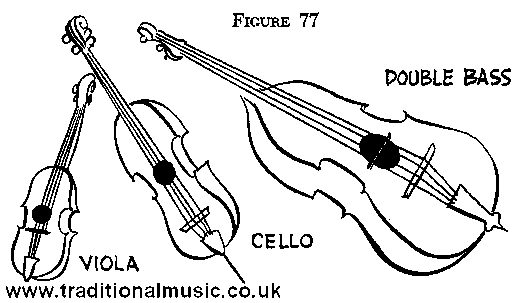It's Easy To Make Music
THE VIOLA, CELLO AND DOUBLE BASS
| Share page | Visit Us On FB |
THE VIOLA, CELLO AND
DOUBLE BASS

We are including pictures of these other members of the
violin family because we think they belong in a book of this
kind; but we are not describing how they are played because
relatively few people wish to learn them as compared with the
number who are interested in the more popular instruments.
The general principles of playing the viola, violoncello and
double bass or, as it is often called the string bass or bull fiddle,
are the same as those used in playing the violin.
The viola stands in point of size between the violin and the
cello and is known variously as the tenor and the alto instru-
ment of the violin family. It is pitched a fifth lower than the
violin and has a sweet, mellow tone, less brilliant than that of
the violin. This is partly because the strings are not tuned to as
high a tension as violin strings.
The cello is considerably larger than the viola and consider-
ably lower in pitch. It has a glorious full, rich tone, which is
invaluable in the orchestra and in chamber music such as trios
and quartets.
The big double bass is the largest of the violin family and
the lowest in pitch. It is so large that the stretches for the
fingers in making notes are very great, almost double those
required for the cello. Owing to the thickness of the strings
real strength is needed to press them against the fingerboard
when they are vibrating. The double bass has become a popu-
lar dance band instrument in recent years, its powerful deep
tones and the rhythmic plucking of its strings providing a
wonderful bass accompaniment to the other instruments.
88